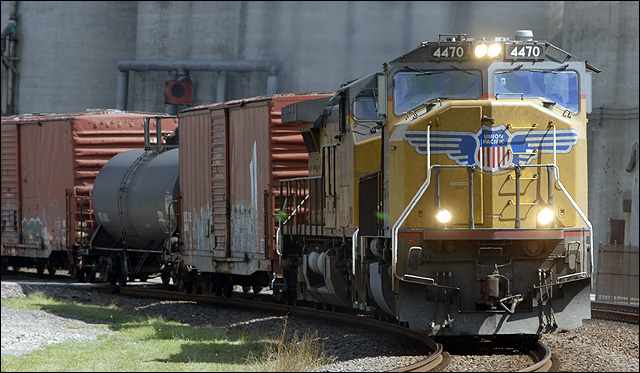More ethanol triggers concern about accident management
Topeka ? The energized ethanol market has been an economic boon to Kansas but also is putting more hazardous cargo on the state’s railroads and highways, officials said Tuesday.
Private industry, state government and emergency responders have joined forces to be prepared should a mishap occur.
“Ethanol is moving in Kansas and other Midwestern states,” Gov. Kathleen Sebelius said, talking to an emergency training group.
Ethanol is not more hazardous than many other chemicals. It’s just that as more of it is produced, more of it is transported along rails and roads, officials said.
Kansas production of ethanol, an alcohol-based alternative fuel made from corn or grain sorghum, has doubled in the last four years and is projected to double again in the next two years, Sebelius said. Current production at Kansas’ eight ethanol plants is more than 215 million gallons per year.
“Kansas is a transportation hub : so whether it is by train, car or truck, we are going to have a lot of hazardous materials traveling though Kansas,” Sebelius said. “So it behooves us to pull together and figure out how we can be prepared for an event should it occur.”
She said cooperation had been high among state Homeland Security agencies, local communities and private industry in Kansas.

A Union Pacific freight train passes through North Lawrence on Tuesday. Trains and trucks are beginning to carry more ethanol, which is flammable. Training is scheduled for 10 Kansas communities to help local emergency personnel prepare for a possible ethanol accident.
“We have all the parties at the table,” she said.
Training sponsored by the chemical and transportation industries was scheduled for 10 Kansas communities to help local emergency personnel.
Lou Wagner, general director of chemical transportation safety for Union Pacific Railroad, said the training is especially important now that Kansas is producing and transporting more ethanol.
“This is something that definitely helps the nation and helps all of us, and we want to handle all of these shipments in the safest way possible,” Wagner said.
Wagner said Union Pacific had seen a 10 percent increase in ethanol shipments from last year. The railroad has moved 3,000 rail cars of ethanol through Kansas, with each car containing 30,000 gallons.
Most of the ethanol is headed to the West Coast or Texas, he said.
A recently completed study shows there is more ethanol and other hazardous substances traveling through Douglas County.
“There is definitely a significant increase in the amount of chemicals coming through, and that (ethanol) is one of them,” said Paula Phillips, Douglas County emergency management director.
The information is included in a “commodity flow study” in which a contractor recorded by sight a random sample of hazardous cargo on roadways and railroads.
Phillips said the information soon would be shared with Lawrence-Douglas County Fire & Medical to determine if there is a need to change any training and procedures.
Many other chemicals are more hazardous than ethanol, she said, such as gaseous chlorine and anhydrous ammonia.
Because it is alcohol-based, ethanol is flammable and has the potential to explode. An ethanol fire would need to be contained with powder or foam instead of water, she said.
The training program put together by the chemical industry brought hazardous material equipment and rail cars to the Topeka railyard. The program already has been put on in Liberal, Dodge City, Wichita, Emporia and Olathe and was scheduled to go to Manhattan, Salina and Hays before concluding Sept. 14 in Oakley.







